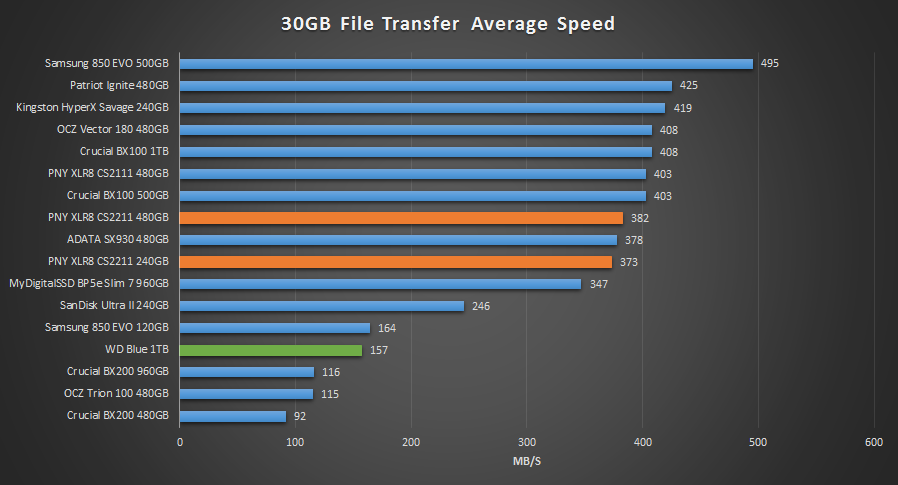REAL WORLD FILE TRANSFER
Finally, we wanted to see how performance was in a real world use when transferring large files to the SSDs. For this test we are going to simply stress write performance by transferring over a 30GB folder of movies off of one SSD to this one and time how long it takes. Once complete we can calculate the average speed.
The above results are decent. Write speeds averaged around 370-380MB/s during the 30GB transfer. While the CS2211 beat out the HyperX savage in PCMark, it was not able to outperform it in a transfer test. However, it was able to beat out the SX930 by a few MB/s. Overall, a solid performance.
POWER CONSUMPTION
For our power consumption testing, we have the drive connected to the system as a secondary drive. To record the wattage, we are now utilizing a Quarch Technology Programmable Power Module. It allows us to accurately measure power consumption over time and is flexible enough to allow us to test any SSD that comes our way.
Our power analysis may change as time goes on, but for now we are looking at just a few metrics with the main goal of measuring our results against the manufacturer’s ratings. One, idle power consumption. Because most consumer systems are at idle for about 80% of the time, idle power consumption is an important measure to look at when understanding the efficiency of a drive. Next we look at startup consumption. This tells you how much power the device needs during startup and while it is usually more important when looking at HDDs and enterprise class storage, it is still something worth quantifying. After that we did averaged out the active power consumption from the 30GB file transfer. Finally, we went through our power logs during testing and listed the maximum power draw.
Here we can see that the results are average with similar drives in this capacity and performance bracket. The max power consumption is well regulated with the 240GB maxing out at 3.3W and the 480GB maxing out at 4.3W. These are much better results than what we have seen with other drives, which reach around the 6W range. The File transfer consumption was also good with results much better than that of the last two TLC SSDs we have reviewed, the BX200 and BP5e.
Finally, we wanted to post up a graph of the difference in idle power consumption between many of the current SSD options in the market. Again, idle accounts for the majority power draw of a drive and considering the use a drive in laptop, idle power consumption can greatly affect battery life, therefore we feel we should compare it in its own graph.
In the chart above we can see that SSDs are magnitudes more efficient than standard HDDs. The PNY CS2211 Series show very well controlled idle power consumption with the 240GB model consuming just 55 milliwatts and the 480GB model consuming only 70 milliwatts.
 The SSD Review The Worlds Dedicated SSD Education and Review Resource |
The SSD Review The Worlds Dedicated SSD Education and Review Resource | 


G’day Sean
Seems the same Phison made drive with 19nm flash is faster,
and possibly cheaper………….
https://www.tomshardware.com/reviews/zotac-premium-edition-ssd,4397-3.html
Hi, yes we are in the process of aquiring one of those drives for review as well! Thanks!
Glad to see reviews again instead of announcements. But It amazes me how these companies advertise their new ssds with so much enthusiasm, when there new ssds are slower than the previous generation. It’s like, yeah we shrunk the nand size again, Woopie!!! And now it’s a little slower but almost as fast.
As long as it performs adequately and the endurance/retention is reasonable, there is nothing wrong. After all, each generation is getting cheaper.
Does this performs better that Samsung 850 Pro and Crucial M550? I am lost which to choose…
Ugh, all the graphs have two SSDs using the white line. which one is which ?
You say this is a TLC Nand but the official website says its an MLC https://www.pny.com/ssd-cs2211 I am going crazy here. Anandtech also says its an MLC.
Well I am going crazy cause many people are saying that TLC drives come in 120/240 capacities and only the MLC come in 128/256 and so on capacities.
I have seen uptill now two brands that have the 120/240 capacites but claim to be MLC one is PNY and the other is Chiprex. So I am confused. These are really cheap but I don’t want it if its a TLC Could someone please confirm
TLC -is- MLC
MLC = Multiple-level cell
TLC = Triple-level cell
Multiple means more than one.. 3 is more than one.
MLC usually means 2 levels per-cell, but manufacturers can sometimes label TLC as MLC.